Magnetically Compatible Brain Electrode Arrays Based on Single-Walled Carbon Nanotubes for Long-Term Implantation
Abstract
1. Introduction
2. Materials and Methods
2.1. SWCNT-Based Electrode Array Fabrication
2.2. In Vitro Recording
2.3. In Vivo Experiment
2.3.1. Animal Handling
2.3.2. Neural Recordings
2.3.3. 7-Tesla fMRI Imaging and LFP Collection
3. Results and Discussion
3.1. Validation In Vitro
3.2. Validation In Vivo
3.2.1. Detection of Epileptic Signals
3.2.2. Performance of Long-Term Implantation
3.2.3. Long Implanted Brain Tissue Immune Response
3.2.4. 7-Tesla fMRI Compatibility
4. Conclusions
Supplementary Materials
Author Contributions
Funding
Institutional Review Board Statement
Data Availability Statement
Acknowledgments
Conflicts of Interest
References
- Girardeau, G.; Lopes-dos-Santos, V. Brain neural patterns and the memory function of sleep. Science 2021, 374, 560–564. [Google Scholar] [CrossRef] [PubMed]
- Bouton, C.E.; Shaikhouni, A.; Annetta, N.V.; Bockbrader, M.A.; Friedenberg, D.A.; Nielson, D.M.; Sharma, G.; Sederberg, P.B.; Glenn, B.C.; Mysiw, W.J.; et al. Restoring cortical control of functional movement in a human with quadriplegia. Nature 2016, 533, 247–250. [Google Scholar] [CrossRef] [PubMed]
- Sun, G.; Zeng, F.; McCartin, M.; Zhang, Q.; Xu, H.; Liu, Y.; Chen, Z.S.; Wang, J. Closed-loop stimulation using a multiregion brain-machine interface has analgesic effects in rodents. Sci. Transl. Med. 2023, 14, eabm5868. [Google Scholar] [CrossRef]
- Dagdeviren, C.; Ramadi, K.B.; Joe, P.; Spencer, K.; Schwerdt, H.N.; Shimazu, H.; Delcasso, S.; Amemori, K.-I.; Nunez-Lopez, C.; Graybiel, A.M.; et al. Miniaturized neural system for chronic, local intracerebral drug delivery. Sci. Transl. Med. 2018, 10, eaan2742. [Google Scholar] [CrossRef] [PubMed]
- Goding, J.A.; Gilmour, A.D.; Aregueta-Robles, U.A.; Hasan, E.A.; Green, R.A. Living Bioelectronics: Strategies for Developing an Effective Long-Term Implant with Functional Neural Connections. Adv. Funct. Mater. 2017, 28, 1702969. [Google Scholar] [CrossRef]
- Vonck, K.; Boon, P.; Claeys, P.; Dedeurwaerdere, S.; Achten, R.; Van Roost, D. Long-term deep brain stimulation for refractory temporal lobe epilepsy. Epilepsia 2005, 46 (Suppl. S5), 98–99. [Google Scholar] [CrossRef] [PubMed]
- Romanelli, P.; Piangerelli, M.; Ratel, D.; Gaude, C.; Costecalde, T.; Puttilli, C.; Picciafuoco, M.; Benabid, A.; Torres, N. A novel neural prosthesis providing long-term electrocorticography recording and cortical stimulation for epilepsy and brain-computer interface. J. Neurosurg. 2018, 130, 1166–1179. [Google Scholar] [CrossRef]
- Darmani, G.; Drummond, N.M.; Ramezanpour, H.; Saha, U.; Hoque, T.; Udupa, K.; Sarica, C.; Zeng, K.; Cortez Grippe, T.; Nankoo, J.F.; et al. Long-Term Recording of Subthalamic Aperiodic Activities and Beta Bursts in Parkinson’s Disease. Mov. Disord. 2023, 38, 232–243. [Google Scholar] [CrossRef]
- Chen, Y.; Wang, S.; Guo, J.F. DCTNet: Hybrid deep neural network-based EEG signal for detecting depression. Multimed. Tools Appl. 2023, 82, 41307–41321. [Google Scholar] [CrossRef]
- Remore, L.G.; Tolossa, M.; Wei, W.; Karnib, M.; Tsolaki, E.; Rifi, Z.; Bari, A.A. Deep Brain Stimulation of the Medial Forebrain Bundle for Treatment-Resistant Depression: A Systematic Review Focused on the Long-Term Antidepressive Effect. Neuromodulation 2023. online ahead of print. [Google Scholar] [CrossRef]
- Aibar-Duran, J.A.; Rodriguez Rodriguez, R.; de Diego Adelino, F.J.; Portella, M.J.; Alvarez-Holzapfel, M.J.; Martin Blanco, A.; Puigdemont Campos, D.; Molet Teixido, J. Long-Term Results of Deep Brain Stimulation for Treatment-Resistant Depression: Outcome Analysis and Correlation with Lead Position and Electrical Parameters. Neurosurgery 2022, 90, 72–80. [Google Scholar] [CrossRef] [PubMed]
- Tringides, C.M.; Mooney, D.J. Materials for Implantable Surface Electrode Arrays: Current Status and Future Directions. Adv. Mater. 2022, 34, e2107207. [Google Scholar] [CrossRef] [PubMed]
- Biran, R.; Martin, D.C.; Tresco, P.A. Neuronal cell loss accompanies the brain tissue response to chronically implanted silicon microelectrode arrays. Exp. Neurol. 2005, 195, 115–126. [Google Scholar] [CrossRef] [PubMed]
- Xiong, J.; Zhang, B.; Balilonda, A.; Yang, S.; Li, K.; Zhang, Q.; Li, Y.; Wang, H.; Hou, C. Graphene-based implantable neural electrodes for insect flight control. J. Mater. Chem. B 2022, 10, 4632–4639. [Google Scholar] [CrossRef] [PubMed]
- Xie, C.; Lin, Z.; Hanson, L.; Cui, Y.; Cui, B. Intracellular recording of action potentials by nanopillar electroporation. Nat. Nanotechnol. 2012, 7, 185–190. [Google Scholar] [CrossRef] [PubMed]
- Wang, Y.; Shao, Y.; Matson, D.W.; Li, J.; Lin, Y. Nitrogen-doped graphene and its application in electrochemical biosensing. ACS Nano 2010, 4, 1790–1798. [Google Scholar] [CrossRef]
- Filipovic, L.; Selberherr, S. Application of Two-Dimensional Materials towards CMOS-Integrated Gas Sensors. Nanomaterials 2022, 12, 3651. [Google Scholar] [CrossRef]
- Tung, N.T.; Tue, P.T.; Thi Ngoc Lien, T.; Ohno, Y.; Maehashi, K.; Matsumoto, K.; Nishigaki, K.; Biyani, M.; Takamura, Y. Peptide aptamer-modified single-walled carbon nanotube-based transistors for high-performance biosensors. Sci. Rep. 2017, 7, 17881. [Google Scholar] [CrossRef]
- Keefer, E.W.; Botterman, B.R.; Romero, M.I.; Rossi, A.F.; Gross, G.W. Carbon nanotube coating improves neuronal recordings. Nat. Nanotechnol. 2008, 3, 434–439. [Google Scholar] [CrossRef]
- Abidian, M.R.; Martin, D.C. Multifunctional Nanobiomaterials for Neural Interfaces. Adv. Funct. Mater. 2009, 19, 573–585. [Google Scholar] [CrossRef]
- Aoki, K.; Saito, N. Biocompatibility and Carcinogenicity of Carbon Nanotubes as Biomaterials. Nanomaterials 2020, 10, 264. [Google Scholar] [CrossRef] [PubMed]
- Gupta, A.; Liberati, T.A.; Verhulst, S.J.; Main, B.J.; Roberts, M.H.; Potty, A.G.; Pylawka, T.K.; El-Amin Iii, S.F. Biocompatibility of single-walled carbon nanotube composites for bone regeneration. Bone Jt. Res. 2015, 4, 70–77. [Google Scholar] [CrossRef]
- Zhao, S.; Li, G.; Tong, C.; Chen, W.; Wang, P.; Dai, J.; Fu, X.; Xu, Z.; Liu, X.; Lu, L.; et al. Full activation pattern mapping by simultaneous deep brain stimulation and fMRI with graphene fiber electrodes. Nat. Commun. 2020, 11, 1788. [Google Scholar] [CrossRef] [PubMed]
- Gao, Z.H. Advances in surface-coated single-walled carbon nanotubes as near-infrared photoluminescence emitters for single-particle tracking applications in biological environments. Polym. J. 2018, 50, 589–601. [Google Scholar] [CrossRef]
- Pan, J.; Xia, J.; Zhang, F.; Zhang, L.; Zhang, S.; Pan, G.; Dong, S. 7T Magnetic Compatible Multimodality Electrophysiological Signal Recording System. Electronics 2023, 12, 3648. [Google Scholar] [CrossRef]
- Zhao, S.Y.; Liu, X.J.; Xu, Z.; Ren, H.Y.; Deng, B.; Tang, M.; Lu, L.L.; Fu, X.F.; Peng, H.L.; Liu, Z.F.; et al. Graphene Encapsulated Copper Microwires as Highly MRI Compatible Neural Electrodes. Nano Lett. 2016, 16, 7731–7738. [Google Scholar] [CrossRef]
- Li, T.; Tang, L.; Li, K.; Liu, B.; Xiao, M.M.; Liu, N.; Ni, W.; Li, Y.; Zhang, Z.; Zhang, G.J. Functionalized carbon nanotube field-effect transistor biosensor for highly sensitive detection of exosomal protein. Anal. Chim. Acta 2023, 1273, 341511. [Google Scholar] [CrossRef]
- Paillet, M.; Michel, T.; Meyer, J.C.; Popov, V.N.; Henrard, L.; Roth, S.; Sauvajol, J.L. Raman active phonons of identified semiconducting single-walled carbon nanotubes. Phy. Rev. Lett. 2006, 25, 257401. [Google Scholar] [CrossRef]
- Liu, Z.; de Zwart, J.A.; van Gelderen, P.; Kuo, L.W.; Duyn, J.H. Statistical feature extraction for artifact removal from concurrent fMRI-EEG recordings. Neuroimage 2012, 59, 2073–2087. [Google Scholar] [CrossRef]
- Park, D.W.; Schendel, A.A.; Mikael, S.; Brodnick, S.K.; Richner, T.J.; Ness, J.P.; Hayat, M.R.; Atry, F.; Frye, S.T.; Pashaie, R.; et al. Graphene-based carbon-layered electrode array technology for neural imaging and optogenetic applications. Nat. Commun. 2014, 5, 5258. [Google Scholar] [CrossRef]
- Filho, G.; Junior, C.; Spinelli, B.; Damasceno, I.; Fiuza, F.; Morya, E. All-Polymeric Electrode Based on PEDOT:PSS for In Vivo Neural Recording. Biosensors 2022, 12, 853. [Google Scholar] [CrossRef] [PubMed]
- Garma, L.D.; Ferrari, L.M.; Scognamiglio, P.; Greco, F.; Santoro, F. Inkjet-printed PEDOT:PSS multi-electrode arrays for low-cost electrophysiology. Lab Chip 2019, 19, 3776–3786. [Google Scholar] [CrossRef] [PubMed]
- Suarez-Perez, A.; Gabriel, G.; Rebollo, B.; Illa, X.; Guimera-Brunet, A.; Hernandez-Ferrer, J.; Martinez, M.T.; Villa, R.; Sanchez-Vives, M.V. Quantification of Signal-to-Noise Ratio in Cerebral Cortex Recordings Using Flexible MEAs with Co-localized Platinum Black, Carbon Nanotubes, and Gold Electrodes. Front. Neurosci. 2018, 12, 862. [Google Scholar] [CrossRef] [PubMed]

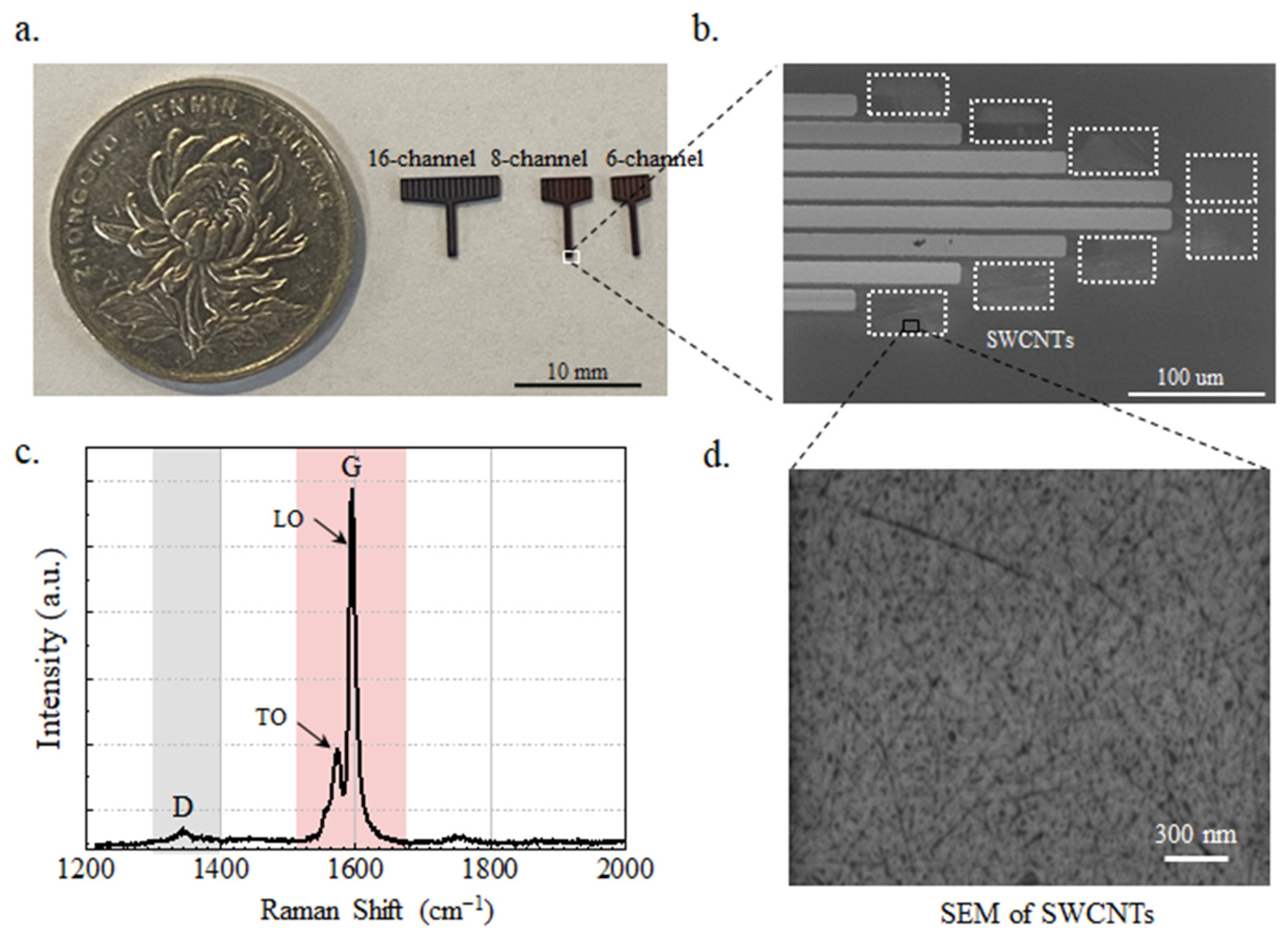

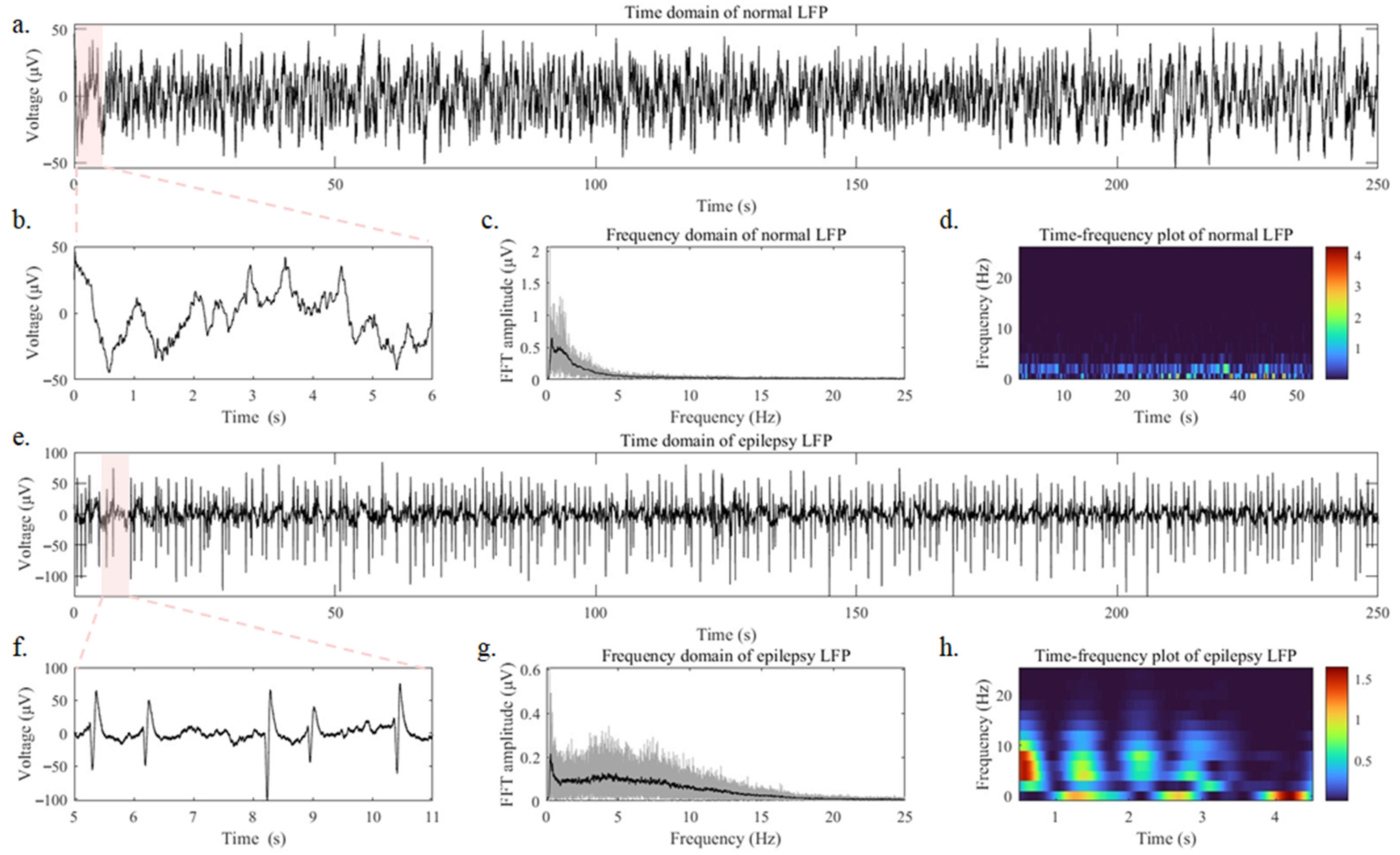
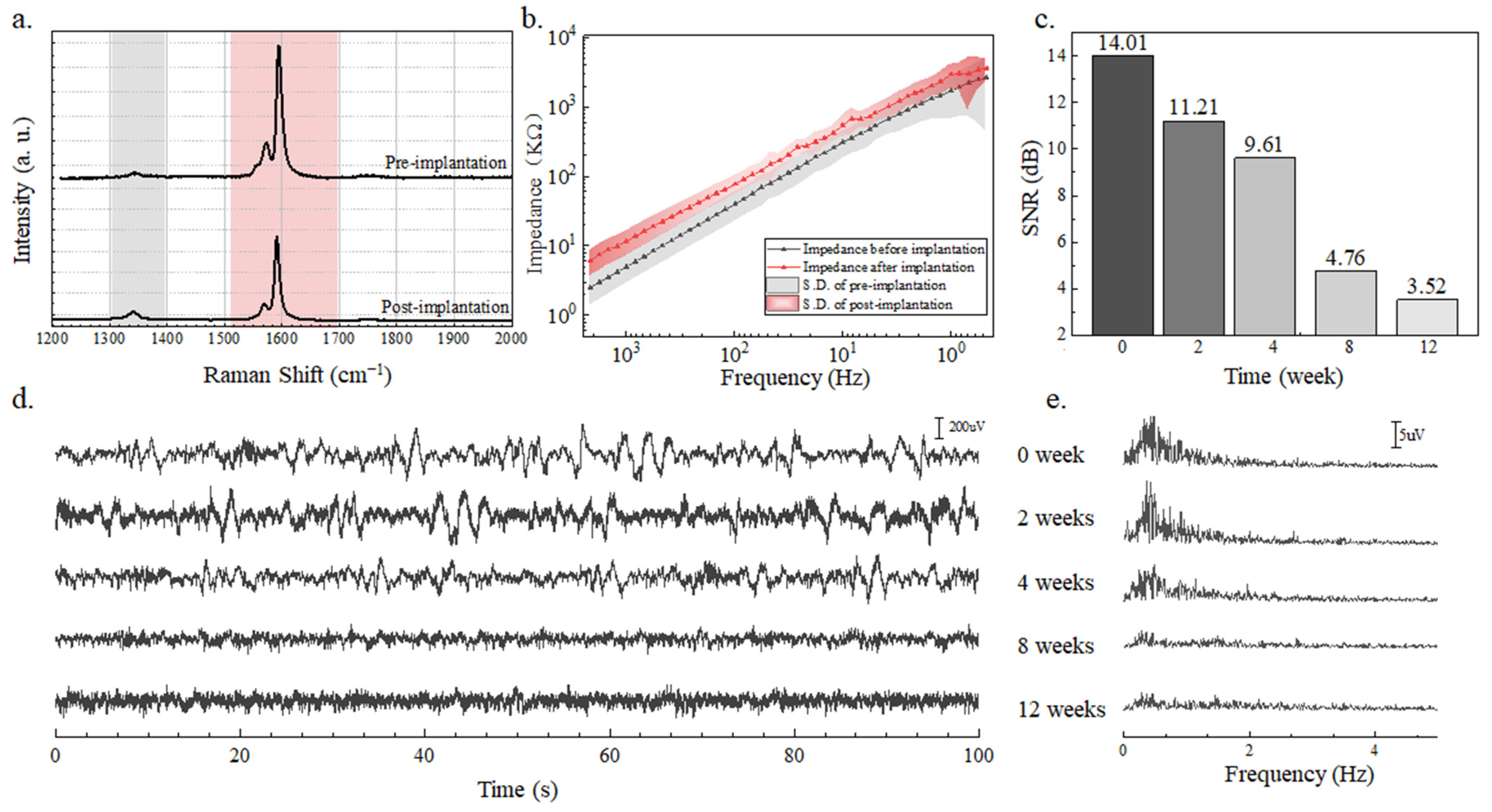
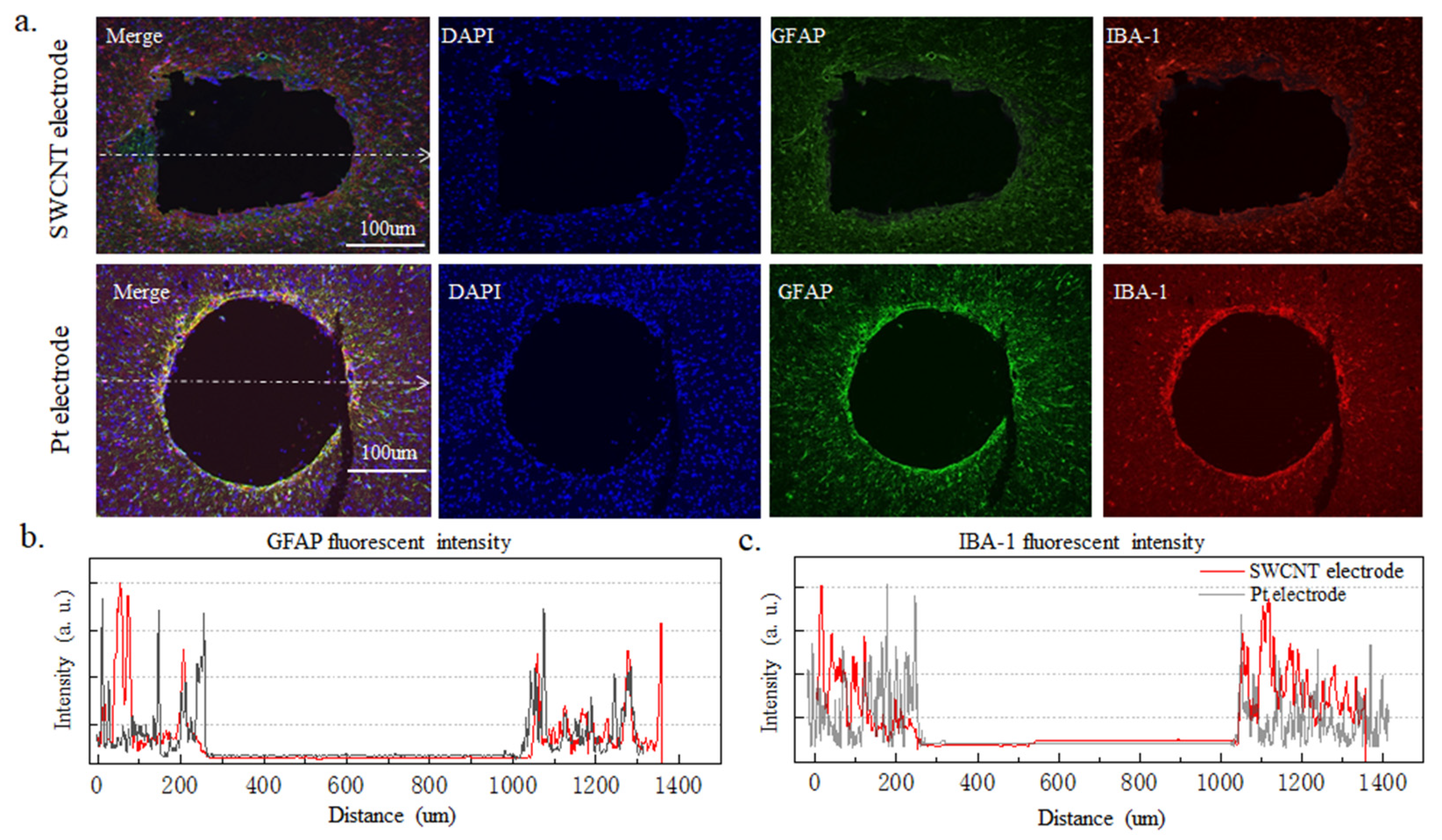
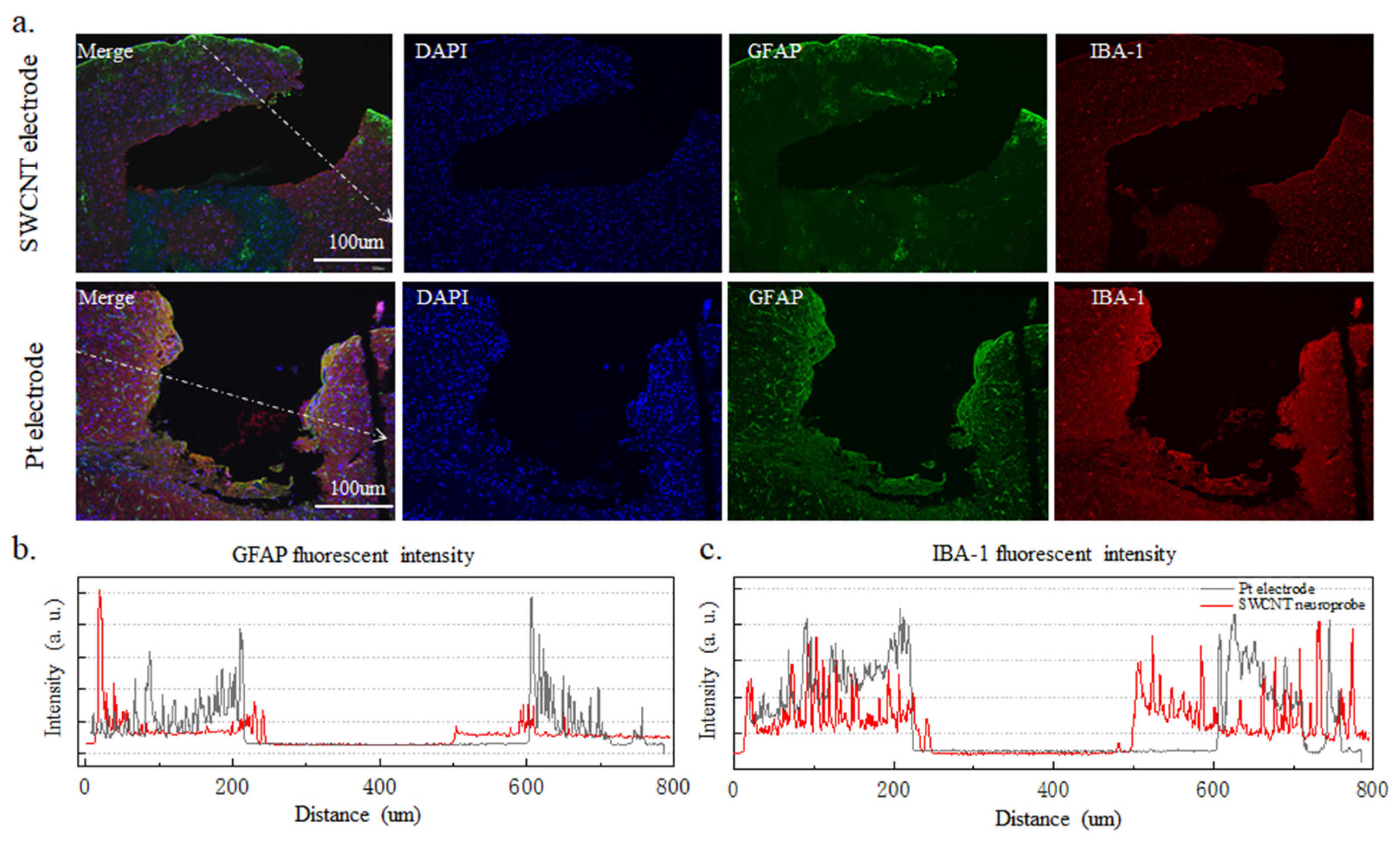
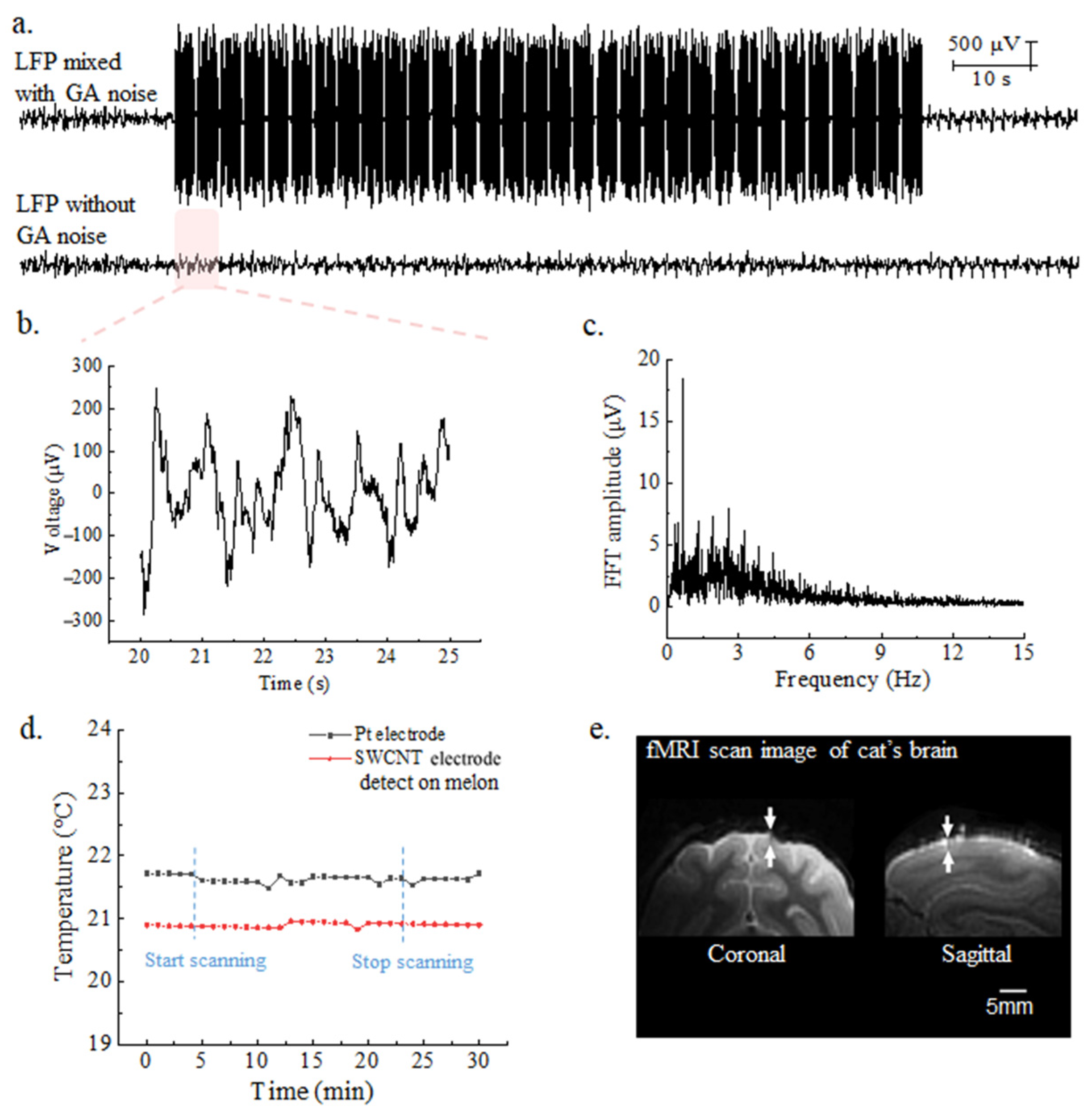
Disclaimer/Publisher’s Note: The statements, opinions and data contained in all publications are solely those of the individual author(s) and contributor(s) and not of MDPI and/or the editor(s). MDPI and/or the editor(s) disclaim responsibility for any injury to people or property resulting from any ideas, methods, instructions or products referred to in the content. |
© 2024 by the authors. Licensee MDPI, Basel, Switzerland. This article is an open access article distributed under the terms and conditions of the Creative Commons Attribution (CC BY) license (https://creativecommons.org/licenses/by/4.0/).
Share and Cite
Xia, J.; Zhang, F.; Zhang, L.; Cao, Z.; Dong, S.; Zhang, S.; Luo, J.; Zhou, G. Magnetically Compatible Brain Electrode Arrays Based on Single-Walled Carbon Nanotubes for Long-Term Implantation. Nanomaterials 2024, 14, 240. https://doi.org/10.3390/nano14030240
Xia J, Zhang F, Zhang L, Cao Z, Dong S, Zhang S, Luo J, Zhou G. Magnetically Compatible Brain Electrode Arrays Based on Single-Walled Carbon Nanotubes for Long-Term Implantation. Nanomaterials. 2024; 14(3):240. https://doi.org/10.3390/nano14030240
Chicago/Turabian StyleXia, Jie, Fan Zhang, Luxi Zhang, Zhen Cao, Shurong Dong, Shaomin Zhang, Jikui Luo, and Guodong Zhou. 2024. "Magnetically Compatible Brain Electrode Arrays Based on Single-Walled Carbon Nanotubes for Long-Term Implantation" Nanomaterials 14, no. 3: 240. https://doi.org/10.3390/nano14030240
APA StyleXia, J., Zhang, F., Zhang, L., Cao, Z., Dong, S., Zhang, S., Luo, J., & Zhou, G. (2024). Magnetically Compatible Brain Electrode Arrays Based on Single-Walled Carbon Nanotubes for Long-Term Implantation. Nanomaterials, 14(3), 240. https://doi.org/10.3390/nano14030240








